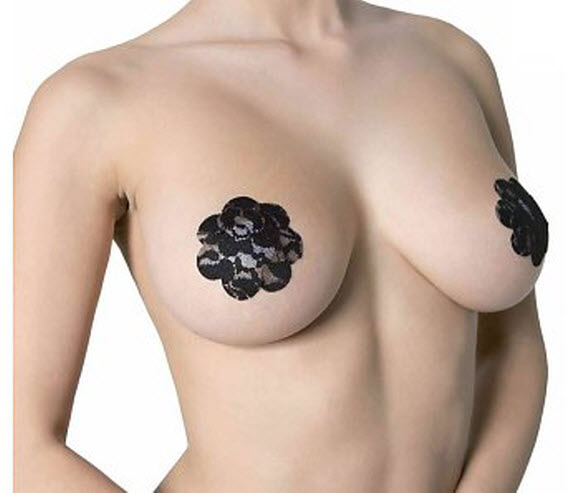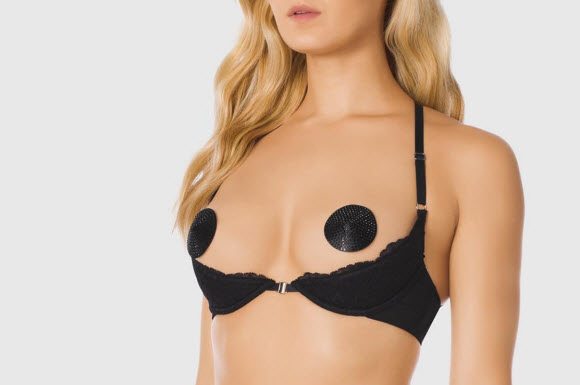Pasties are patches that cover a person’s nipples and areolae which are affixed with adhesive.
Though pasties are commonly associated with strippers, burlesque shows and erotic entertainment, they are also at times worn more casually as an undergarment and occasionally as beachwear. As an example of rarer use, in the annual “Go Topless Day” protests in the United States, otherwise topless female demonstrators wear imitation nipple pasties over their own nipples, to avoid potential prosecution under indecency laws.
Design
Pasties come in a variety of colors, diameters, and shapes. Though pasties come in a variety of sizes, they usually are not much larger than the areola. Pasties are usually applied with a special tape or glue fixative, often gum arabic. However, in some situations keeping pasties from falling off can be an issue, as can be their removal. Some women are allergic to some adhesives or pastie material. Due to this, most high quality nipples are made of hypoallergenic silicone and use special adhesives to reduce the chances of an allergic reaction. Some pasties are for single-use, while others are washable and can be reused.
A sideless bikini bottom is sometimes worn to complement a pasties top outfit, this can be a C-string held by an internal flexible frame or other pasties sustained with adhesive, commonly known as a merkin. These pasties for the genitalia are known as maebari in Japanese.
Entertainment
Pasties emerged in burlesque and striptease in the 1920s as a way to avoid breaking the law by performing topless or nude. Pasties came to be regarded by some as more aesthetic and erotic. They were worn in cabarets such as the Folies Bergère and Le Lido. Burlesque performer Carrie Finnell is attributed with adding tassels which hang from the center and incorporating tassel twirling as part of a performance. Tassel twirling has evolved to include Fire Tassels.
In parts of the United States, erotic dancers wear pasties in strip clubs to avoid prosecution under local public indecency laws. In extreme cases, liquid latex pasties are used to comply with local laws, raising criticism by strippers that lawmakers are engaging in cruelty by requiring use of adhesive material on the nipple. Pasties are worn by many neo-burlesque performers and are also found in night clubs, fetish parties and parades, such as Pride Parades.
Pasties were and may still be worn by some actresses while filming an otherwise apparently topless or nude scene, which is not caught by the camera angle.
Underwear
Some women wear pasties when wearing a strapless or backless dress. Some women who choose to be braless may at times wear pasties. They may wear pasties so that their nipples and areolae are not visible through sheer clothing or lingerie, or in case they experience a nipple erection. Some women wear pasties to avoid irritation of the nipples by rubbing against the fabric of the outer garment. When worn under clothing pasties are sometimes called breast petals or nipple covers.
Swimwear
Pasties are occasionally worn on beaches to maximize a sun tan, short of being topless or nude, and avoid the strap lines which bikinis produce. Swimwear named strapless bikini (not to be confused with bandeau bikini tops) or no string bikini by various manufacturers is basically a combination of pasties with a matching maebari-style bottom.


